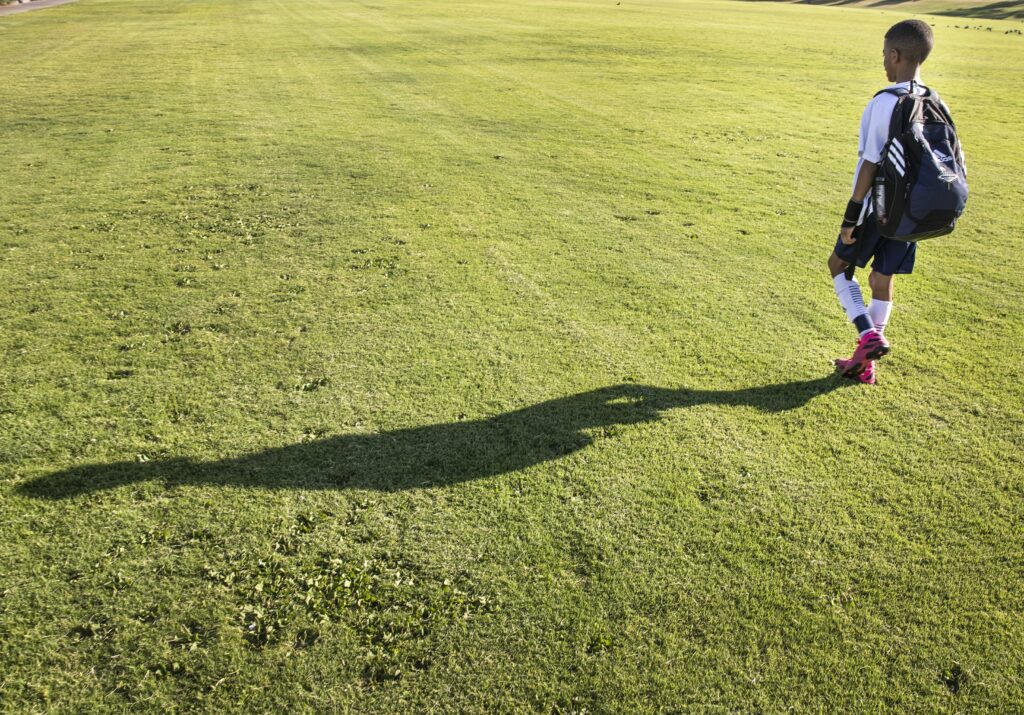Families face agonizing dilemmas over keeping kids safe amid pandemic resurgence
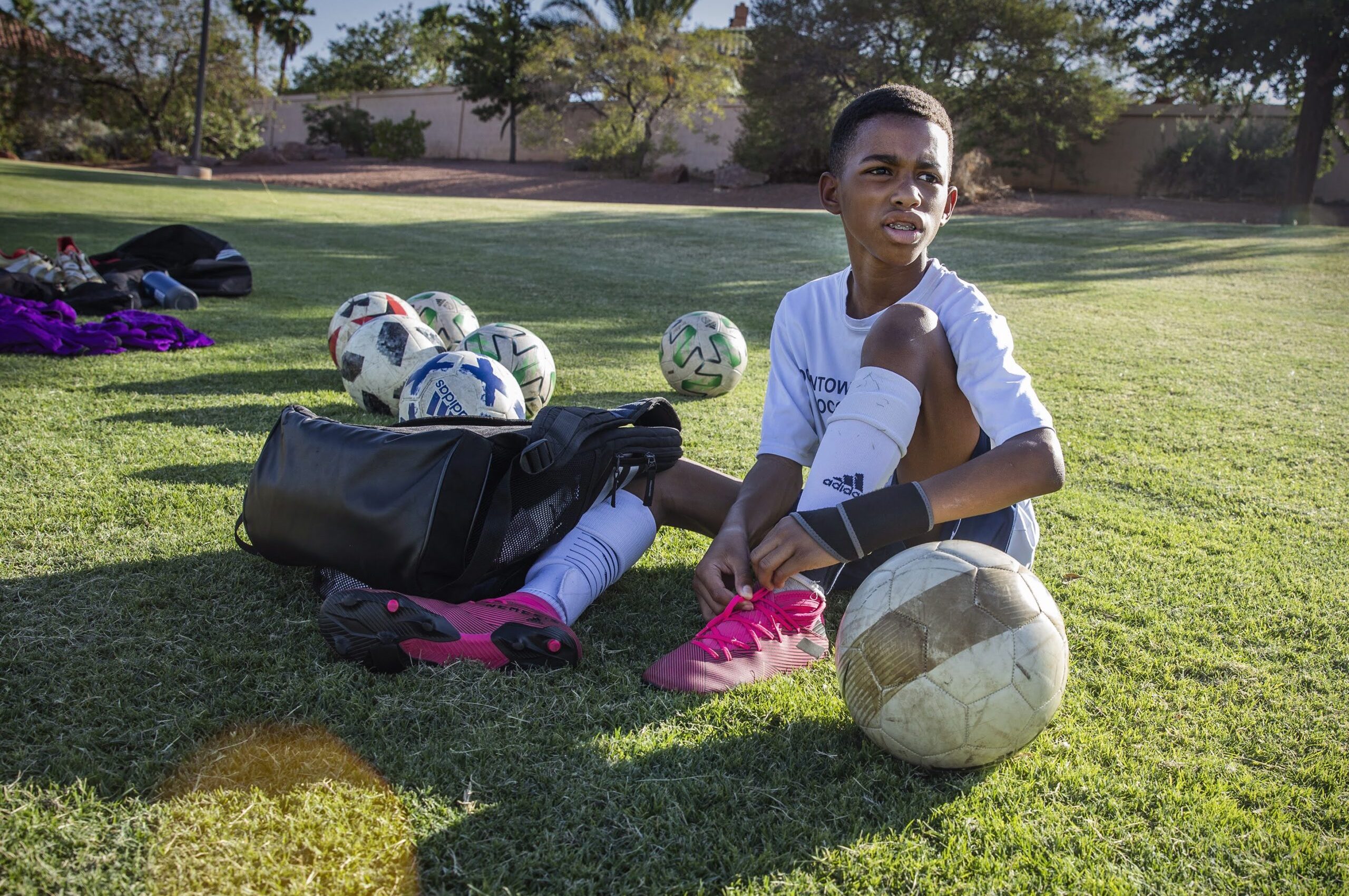
Nate Young is not a kid of many words.
Lacing up his bright pink soccer cleats before practice on a warm summer evening in Las Vegas, the 11-year-old described his bout with COVID-19 in June as “not easy.”
His mom, Nichole, says it was a roller coaster.
Some days Nate felt fine, whiling away the hours playing video games. Some days he didn’t have energy to do anything. Quarantine came and went. A week later, Nate started experiencing severe gastrointestinal symptoms.
“He was in the bathroom, and he was just screaming in ways that I’ve never heard from him,” Nichole Young, 41, said. “He was like, ‘Mommy, please help me. Can you please?’ I went into the bathroom and he’s crying, he’s slumped over and half laying on the tub.”
Worried Nate had developed a rare, inflammatory condition associated with COVID-19 in children, Young rushed her youngest son to the emergency room. X-rays and tests showed no signs of the condition, known as MIS-C, but Nate’s abdominal issues wouldn’t go away.
Two months later, his symptoms have improved but still haven’t resolved entirely.
Doctors have ruled out every other cause and suspect it may be long COVID, Young said, though they have no idea how long it will last.
She thinks back to how worried she was about her 15-year-old son Marlon, who is immunocompromised, catching COVID-19. Young wasn’t as concerned about Nate, who ended up contracting COVID-19 during what was supposed to be a safe, small gathering of two families of four in Orlando.
Everyone except Nate had either been vaccinated against or recovered from the virus. But a couple dozen of the other family’s relatives from Miami showed up, too, and the family vacation turned out to be a super-spreader event, Young said, with one person infecting about 15 other people, Nate included.
“It was the first and only time that we let our guard down and trusted people who we thought were on the same wavelength as us, and that ended up not being the case,” Young said. “The one that we kind of weren’t so worried about was the one to get it because I let my guard down.”
The Young family is just one of many in Nevada and across the country grappling with how to respond to the current moment in the pandemic. Many live in mixed-status households where parents, elderly family members and older kids are vaccinated while their younger children under the age of 12, not yet eligible for the shot, are not.
For some mixed-status families, activities that seemed relatively safe in June have felt increasingly less so amid the rise of the highly transmissible Delta variant, which is now responsible for 9 in 10 new cases in Nevada. While COVID-19 continues to hit adults far harder than it does kids, public health experts say the fact the virus is simply better at spreading than it used to be means kids are at more risk for catching it now than they have been at any other point in the pandemic, and data show pediatric cases represent a growing share of COVID-19 cases in Nevada.
Fortunately, most kids continue to experience few to no symptoms from the virus, and only 10 people under the age of 20 have died from the virus in the state since the beginning of the pandemic. Nevada has also so far been largely spared from the crush of pediatric patients filling up hospital wards that other states have seen, with children comprising less than 1 percent of all currently hospitalized COVID patients in the state, according to the Nevada Hospital Association. Doctors here say the children they are treating in the hospital now don’t seem any sicker than others they have seen during previous waves.
Still, there are kids like Nate who get sick enough from the virus to warrant a trip to the emergency room and continue to deal with the consequences of having contracted it two months out.
It has presented many parents, particularly of unvaccinated children, with a dilemma heading into the fall: how to balance their children’s mental and physical health needs while weighing the risk, however small, posed by the virus.
For some families, it’s business as usual. Others have returned to some of the restrictive measures they were taking last year. Many are trying to navigate a middle ground.
“We have to look at that risk-benefit calculation. You have to look at what’s the risk of doing something and what’s the benefit you get out of it,” said Brian Labus, an assistant professor of public health at UNLV. “Unfortunately, for every single kid that calculation is different because the risks are going to be different and the benefits are going to be different.”
There are bigger-picture consequences of those individual decisions, too. Public health experts say protecting kids is an end in itself, but there are other considerations as well: What about vaccinated family members who are elderly or immunocompromised? Or teachers and frontline service workers who may be at more risk? An unvaccinated kid who picks up the virus might not fall seriously ill but could spread it to someone else who might.
In the pandemic of the unvaccinated, it is the kids who have found themselves in the eye of the storm as their parents debate over masks, vaccines and individual liberties.
It’s the kids who will, once again, shoulder the weight of the consequences.

‘I don't want to die’
Katie Rankin knows this all too well.
When she came down with COVID-19 in mid-February, the then 15-year-old competitive swimmer was more worried about her family than she was about herself. However, a few days after testing positive, she started getting intense, light-induced headaches that prevented her from attending virtual school and sinus pressure so severe it made tear up and cry. Katie said she was tired all the time but also couldn’t sleep, so she ended up laying in bed for 20 hours a day.
Early one morning, a couple of weeks after testing positive, she woke up her mom.
“Katie came and woke me up and said, at 4:30 a.m., ‘Mom, take me to the emergency room. I can’t breathe. I don’t want to die,’” Rochelle Rankin said.
Katie was at the emergency room for two hours before being sent home with instructions to take ibuprofen, her mom said. Katie’s symptoms persisted for six weeks, leaving the straight-A student barely able to get out of bed. When she tried to walk down the stairs, her heart would race and she would get lightheaded. Once she finally started feeling better and moving around more, she developed a new symptom: leg pain.
Searching for answers, Rochelle Rankin found two Facebook support groups for parents of kids with long COVID, and, eventually, a doctor diagnosed Katie with the condition and put her on medication for heart damage and nerve pain. Wearing compression socks 24 hours a day and getting both doses of the COVID-19 vaccine seemed to help, too, Katie said.
It’s only now, six months after testing positive, that Katie is finally starting to feel better. Last week, the doctor said she could stop taking all of her medication except the one for nerve pain. Though she missed the swim season earlier this year, she is working on building up her strength by lifeguarding. But she still gets fatigued and has leg soreness and cramps just walking across campus all day with her school supplies, including her Chromebook.
“I was swimming five to six days a week for two hours a day, and now I can just barely walk around my school and have enough energy to come home and do my homework or work,” Katie, now 16, said. “It’s really, really night and day.”
Her mom, meanwhile, looks back with regret. She says she is the one who brought COVID home after going out to eat dinner one night.
“I really wish I could go back and change that,” Rochelle Rankin said. “We were actually really pretty careful. My son and my husband both have severe asthma, so we really were very careful. I wasn’t concerned about Katie.”
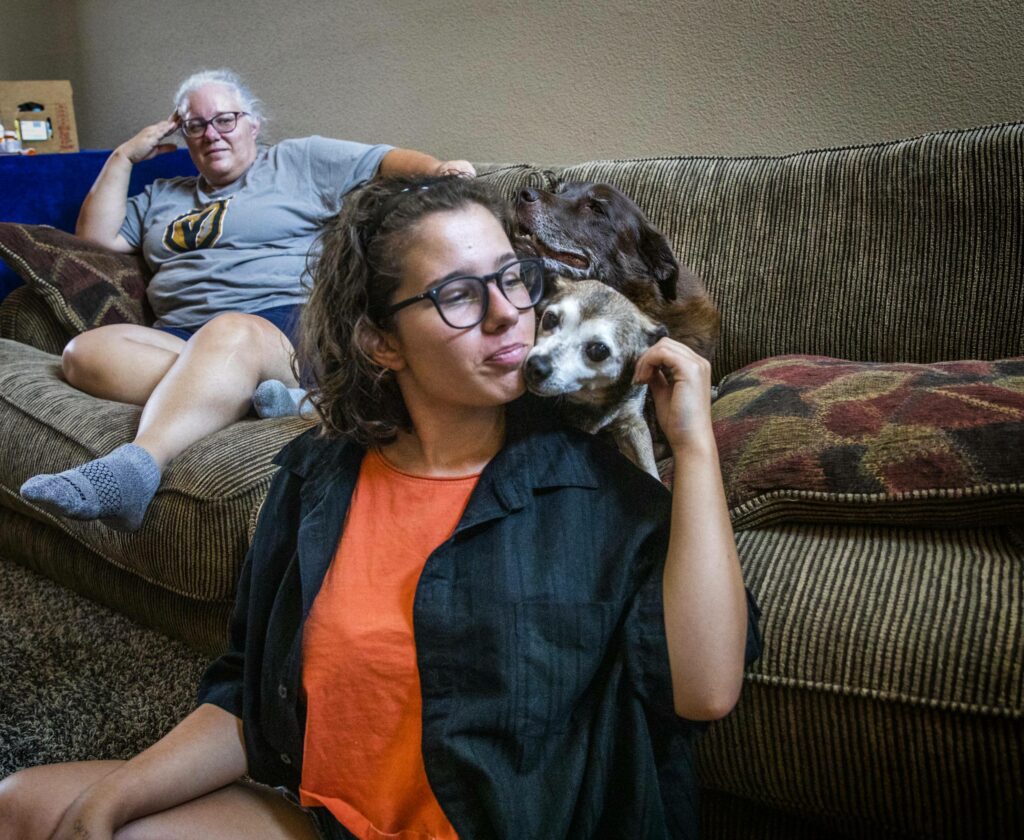
Rankin, like many other parents, thought her daughter would be fine if she caught COVID — and many are. Since the beginning of the pandemic in Nevada, more than 50,000 people under the age of 20 have tested positive for COVID-19, but only 0.02 percent of them have died. Compare that to the roughly 25,000 people 70 and older who have tested positive, of which about 14 percent have died.
But kids can still fall very ill with COVID-19. A study of British children published earlier this month found that although most kids with the virus have few to no symptoms and recover within a week, 4.4 percent have symptoms that last four weeks or longer, while 1.8 percent have symptoms that last for eight weeks or longer.
At the same time, both the UMC Children’s Hospital and Sunrise Children’s Hospital in Las Vegas have reported recent upticks in pediatric emergency room patients with COVID-19. During the current surge, the test positivity rate in the pediatric emergency department at UMC has been as high as 17 percent, down from a height of 25 percent during last summer’s surge but significantly up from a low of 3 percent in September, according to UMC data.
“Of course we’re very concerned because the schools are now reopened, and that’ll undoubtedly be a challenge,” said Dr. Jay Fisher, medical director of the pediatric emergency department at UMC Children’s Hospital.
What they aren’t seeing, though, is the high volumes of admitted pediatric patients that children’s hospitals, particularly in the South, are seeing. As of Thursday, there were only nine kids in the entire state hospitalized with confirmed or suspected cases of COVID-19. In the last four weeks, that number has fluctuated between four and 19.
The Nevada Hospital Association, in a report this week, said pediatric patients with COVID-19 are not stresing available hospital capacity in Northern or Southern Nevada.
For their part, doctors aren’t sure why the situation hasn’t been as bad in Nevada, though they do attribute, at least in part, the implementation of mask mandates in high transmission counties across the state for preventing more pediatric cases.
“I think our public health measures, our vaccination rates slowly creeping up, I think those are reasons why we’re doing better than say Texas or Florida,” Fisher said. “In general, our public health measures have been not optimal here, but we've done reasonably well.”
Nevada hospitals have also not seen the unusual summer outbreak of RSV, a respiratory virus that typically peaks in the winter, that hospitals in other states have. Doctors here say they are just starting to see an uptick in RSV cases, as well as other viruses that generally crop up with the start of school.
The other good news is that while some doctors in other states have reported seeing more severely ill children now than they have at other points in the pandemic, Fisher said UMC has actually seen fewer cases of MIS-C, the rare inflammatory syndrome, in the last eight weeks, though they are still seeing pediatric patients presenting with pneumonia-type illness.
Still, children represent a growing share of COVID-19 cases in Nevada. A year ago, children and teens represented 14 percent of monthly cases, compared to 18 percent today. Public health experts attribute the rise to the transmissibility of the Delta variant, the fact that most kids still aren’t eligible for the vaccine and the fact that, among those who are, many have still not gotten the shot.
More cases of COVID-19 means more chances that one of them will develop a more serious version of the illness, Labus, the public health professor at UNLV, said.
“The odds are that they won't,” Labus said. “But if you repeat that in tens of thousands of households, eventually you’re going to have that exact situation occur.”
Dr. Todd Zimmerman, medical director of Sunrise Children’s Hospital’s emergency room, said most children 12 and older who have come into the hospital seriously ill have not been vaccinated.
“If you are over 12 and you are very sick, then usually you’re not vaccinated,” Zimmerman said. “That’s pretty consistent.”
Fisher says hospital staff try to have conversations with parents about getting their eligible kids vaccinated when they come in. COVID-19 isn’t like other viruses, he warns, because of the way that it impacts the immune system and the heart.
“We tend to lump viruses all together,” Fisher said. “But this one’s different.”
‘Somewhat of a normal life’
Since the beginning of the pandemic, people of all ages have been tasked with navigating the risks that certain behaviors pose to them. At the beginning of the pandemic, they had a shorthand for judging those risks: Whatever the behavior, seniors were, generally, at greatest risk, while kids were at the least risk.
Now that vaccines are widely available and the Delta variant continues to spread, that shorthand has become muddied, leaving families grappling with whether, for instance, a vaccinated 70-year-old is at greater risk from COVID-19 than an unvaccinated 10-year-old.
Heading into the fall, parents of unvaccinated children have been put in the difficult position of charting a new course of what it looks like to keep their families safe, especially as many have returned to in-person schooling this month. They’re balancing a desire to keep their families safe and healthy while also ensuring their kids are getting the educational and socialization opportunities they need.
Take the Morgan family: Russ Morgan, his wife, their 17-year-old daughter and their 14-year-old son have been vaccinated against COVID-19. The youngest, Olive, is 10 and too young to get the shot. When the vaccinated members of the Morgan family were allowed to shed their masks, Olive diligently kept hers on.
“We understand that that age group isn’t necessarily at a huge risk for hospitalizations and complications. We know that it is possible,” Russ Morgan, 45, said. “She just doesn’t want to take those risks.”
Though the Morgan family has stopped going out in public as much as they did earlier in the summer, whether to restaurants or to the movie theater, they still have tried to return to normal life as much as possible, sending the kids to school and extracurricular activities and attending church in person.
But they have done so cautiously. Morgan said they keep at-home COVID tests on hand so if one of the kids wakes up with a runny nose or an upset stomach, they can quickly test for the virus and figure out how to proceed.
The family is particularly focused on their oldest daughter, Mia, having a normal senior year — though that has already proven difficult. One week into a two-week-long band camp, Mia and the rest of the group were sent home to quarantine after an exposure. Instead of spending the week at band camp, Mia spent it with her father trying to find somewhere that would test her and provide official documentation so she could start school on time the following week.
“One of our biggest hopes for this year is that it can be somewhat of a normal senior year because she didn’t have a normal sophomore year and her junior year was completely wiped out,” Morgan said. “She’s been doing great. It’s been really good for her, I think, to be with her friends, to be with people, being able to have those experiences again and be able to reintegrate into somewhat of a normal life.”
Normal is easier said than done, though. At least one Clark County school, Frank Lamping Elementary School in Henderson, transitioned to 10 days of distance learning this week after multiple people tested positive for the virus, while the Reno Gazette-Journal reported a Washoe County parent knowingly sent their child to school last week with COVID-19, exposing more than 80 students to the virus.
According to a dashboard maintained by the Clark County School District, there have been 454 confirmed cases of COVID-19 districtwide this month, including 115 this week — though it is unclear how current the dashboard is given that it continued to show no cases at Lamping as of Friday evening.
“As you bring people together, there's obviously that potential for transmission. The question is, how much transmission is there going to be and is the school taking adequate steps to prevent that transmission in the first place?” Labus said. “They know people are going to bring the virus in the school. Are they taking all the steps they can to try and stop disease? And it seems like, at least in Southern Nevada, that’s been the approach, but not all school districts are doing this the same way.”
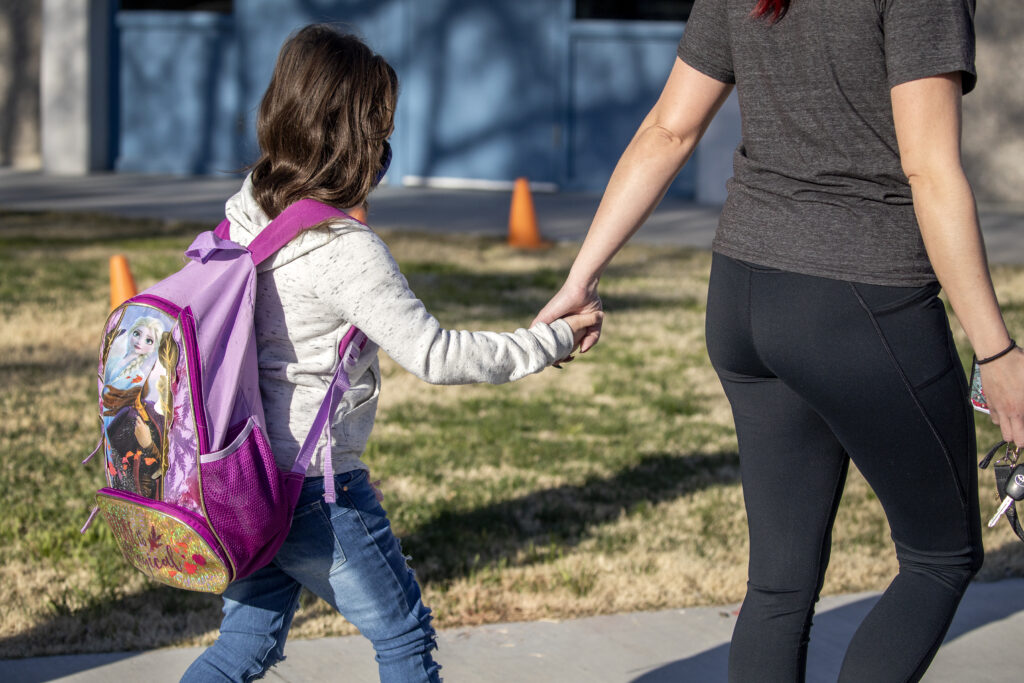
For 36-year-old dad Aidan, who asked to be identified only by his first name, the rules at his 5-year-old daughter’s school have been frustrating. At recess, the kids are allowed to run around on the grass next to each other unmasked but have to mask up to use the playground equipment, he said.
“Next to each other on the grass is no different than next to each other on the slide,” Aidan said. “It doesn’t seem to be very consistent.”
Though Aidan was initially wary of getting the vaccine, he settled on getting the Johnson and Johnson shot and has since convinced several of his coworkers to get vaccinated, too. While he’s not opposed to vaccinations generally, he says he doesn’t plan to vaccinate his daughter and 3-year-old son once they are eligible to get the shot because of how new the vaccine is.
And while Aidan says it’s "getting annoying" to be mandated to wear a mask, he said his daughter seems to mind it less than he does.
“It’s no big deal. She puts the mask on, goes to school, and she doesn’t mind whatsoever,” he said. “She doesn’t know any different.”
But asking people to mask up, as the state and school districts have done, is easier said than done. On one end, there are parents who have taken to school board meetings to protest mask mandates in classrooms. On the other, there are families that never stopped masking even after vaccination. Many fall somewhere in between.
All the while, public health experts have noted that masking remains the one mitigation measure that, in addition to being effective at stopping the spread of COVID-19, doesn’t require businesses to limit their capacity or close their doors to stop the spread.
“Even if it just prevents a small number of cases, that’s a big deal when you’re talking about exposures in school,” Labus said. “It’s about taking steps, simple steps, to protect children in classrooms.”
But it doesn’t stop at protecting children, Labus said. Protecting kids means protecting the community as a whole.
“The kids could get an infection and have a mild or asymptomatic disease but could still serve as a source of infection for even vaccinated people in the household,” Labus said. “It’s hard to think of yourself not just as an individual but as a link in a chain.”
Best-case scenario, public health experts would like to see families do more than just mask up and once again be deliberate about the kind of contact they are having outside their household.
“It makes sense to go back to a lot of the things that we were doing before, being careful about wearing masks, deciding if you really do need to make that trip out in public,” Labus said. “You may be making different decisions about going to an event now, whereas in early June you’d be more comfortable doing it just because we have this new variant in the community that spreads pretty easily.”
That’s essentially what the Fowler family did. Ezra Fowler, his wife, and their 12-year-old daughter are all vaccinated, but their two 8-year-olds and 5-year-old are not. As a result, they consider their family only 50 percent vaccinated and approach everything they do as if it is high risk.
“It’s important for the little ones to be protected,” Fowler, 47, said.
While all four kids are back in school in person, the family has taken significant steps to limit their risk. The 12-year-old daughter is back to Zoom piano lessons after briefly having resumed them in person with a mask. When the grandparents come over to the house, they all wear masks.
It’s about protecting the kids, Fowler says, but also about making sure one of them doesn’t pick up COVID at school and give it to one of their grandparents.
“I think about it as, at what level is Russian Roulette a good time? I definitely think that one out of six is not a good time. Is one in a million? Is one in 330 million?” Fowler, who lives in Las Vegas, said. “Even if I’m not going to die, do I want my kids in the hospital, ever? So we just play it safe.”
He says life would be different if all of his kids were able to get the vaccine. Things that seem unimaginable right now — including going to a movie — might finally be back on the table.
“I would think we would think things were pretty close to normal and we would continue to just watch what’s recommended,” Fowler said. “That’s the main thing stopping me from any activity. I just don’t even consider what the options are.”
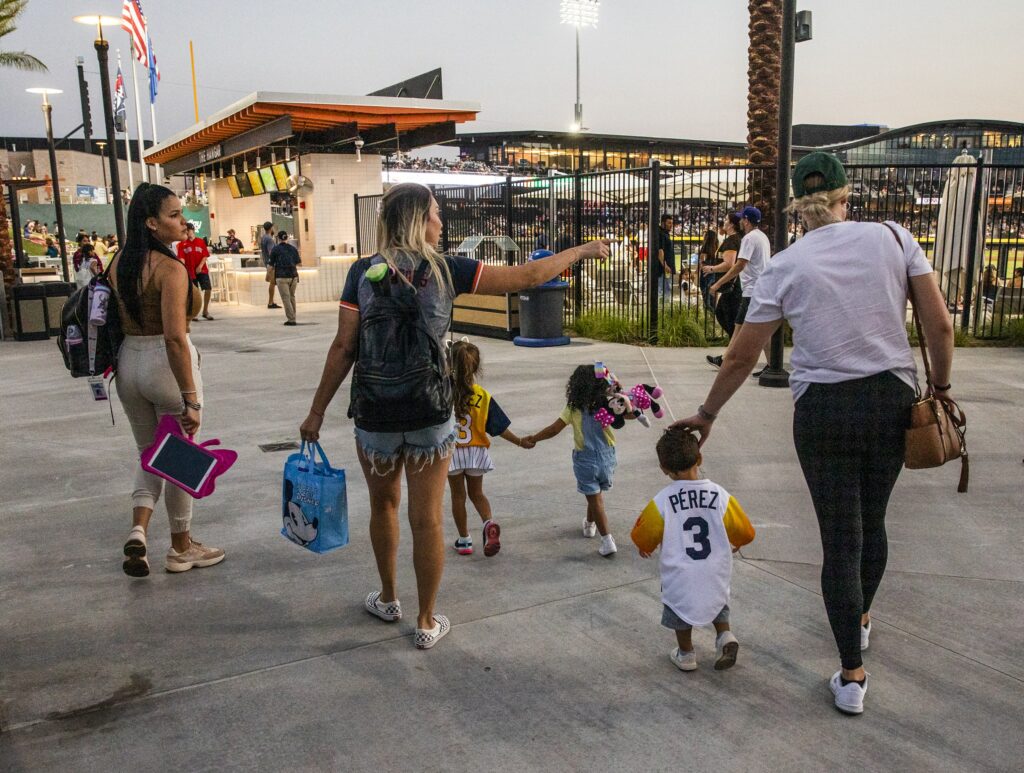
‘An illness not to be socializing’
Pandemic life is all John Jones has ever known.
John was born the day after the first COVID case was identified in the U.S. Now, 19 months later, he still hasn’t really played with other kids, his father, Mike Jones, says.
“It was probably about March of this year … that I thought, ‘Oh, I guess I could take him to the park. That’s outside. That’s probably safe,’”Jones said. “It was probably the first time he’d ever seen other kids. He’s still very shy around them, very nervous, although he has started waving at people.”
Jones and his wife, who live in Carson City, have made a concerted effort to keep themselves and John, who was born after a few miscarriages, as safe as possible during the pandemic. Jones said he took John with him to Target and Walgreens a couple of times when case numbers started to drop and John spends time with his wife’s family who live nearby, but his son still hasn’t met many people in his life.
Though both Jones and his wife are vaccinated, John remains ineligible for the shot. It makes Jones, who has contact with the public in his job as a sales representative, nervous.
“He’s going to be our only kid,” Jones, 40, said. “It was very hard to get him. We don’t want anything to happen to him.”
Jones does wonder, though, about the long-term impact of the pandemic on his son socially.
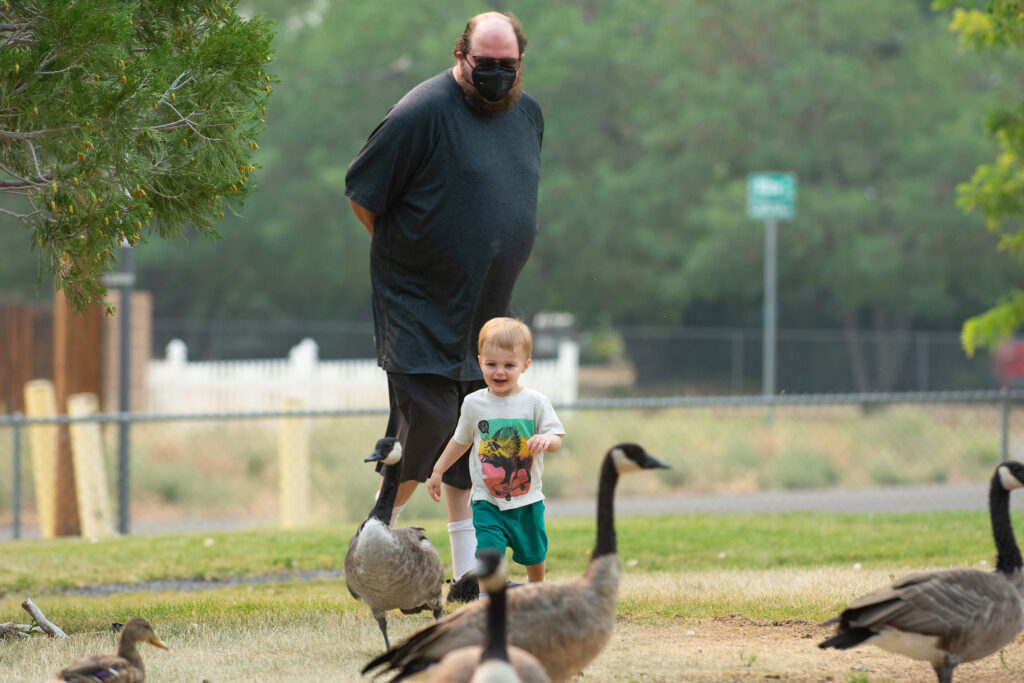
“Because of where we live, it feels like at least half the town doesn’t take any of this seriously,” Jones said. “You have to wonder, when he does go to school, how is he going to fare versus the people who’ve just gone on living their life normally during this whole thing?”
Doctors and public health experts have said the best way for parents to protect their unvaccinated children is to cocoon them with vaccinated people, whether adults or older children. But they also recognize that keeping kids in a bubble for a year and a half and counting comes at a high cost.
Fisher, the medical director of the pediatric emergency department at UMC Children’s Hospital, sees the push and pull between children’s physical health needs and mental health needs firsthand. While the hospital continues to see an increase in pediatric COVID-19 patients, it remains “very busy” with pediatric mental health patients, with kids often waiting days in the hospital for longer-term psychiatric placements, he said.
“I think I tend to be more of a bubble wrap guy as a pediatric emergency doctor, but I recognize it’s an illness to not be socializing, also,” Fisher said. “I really feel for parents right now. I’m a parent myself — my kids are older — but I feel for them. It must be very, very difficult.”
Dr. Lisa Durette, the fellowship director of the child and adolescent psychiatry and behavioral health at UNLV School of Medicine, says the decisions families make for themselves and their children from a mental health perspective will likely look different depending on their kids’ needs.
Some kids with social anxiety and social phobia “flourished” during quarantine, she said, and may be struggling with a return to school. On the other hand, extroverted kids who slipped into depression and social withdrawal last year may be thriving now that they’re back in the classroom.
“Every family is going to have to make the decision that’s right for them,” said Durette, noting that perhaps the only wrong decision is testing positive for COVID-19 and then knowingly exposing others to the virus. “Short of that, it’s what’s right for each family and, whatever decision a family makes, being able to communicate it with honesty and transparency to their kids is really important.”
There’s a third group Durette worries most about, whom she calls the lost kids. Those are the children who fell through the cracks over the last year: the ones who were already grappling with negative social determinants of health, including poverty, housing instability and other stresses in the home, and the ones who didn’t log on for Zoom class or struggled to get to school in the hybrid learning environment.
“What’s happened to all of these kids that we just don’t know, hands off, sight unseen?” Durette said. “That’s really worrisome.”
On top of that, the return to in-person schooling has already been far from normal for many kids, who have had to quarantine because of exposures in the classroom. Durette said parents should try to be open with their kids about the reality they might have to pivot back and forth this year between in-person school and virtual learning, if sent home on quarantine.
“As parents and caregivers, some of the best things that we can do is have honest dialogue with our kids,” Durette said. “‘This is not pleasant for any of us, and we don’t know what’s going to happen. We do know that we don’t know. We know that you might end up back home on a quarantine, and if it happens, we’ll just roll with it.’”
Tiffany Tyler-Garner, executive director of the Children’s Advocacy Alliance, said that ping pong between in-person school and quarantine will likely be even more difficult for vulnerable families who don’t have the resources to quickly pivot to distance learning. That’s why, she said, it’s even more important for families to work together to keep each other safe.
“Maybe you were already having challenges finding [child care] during the hours you needed it and, on top of it, needing to be prepared to quarantine throughout this next school year,” Tyler-Garner said. “If you were already living paycheck to paycheck, or an hourly employee that really needed to make every hour count … then how are you managing now?”
Mental health professionals don’t know what the long-term ramifications of the pandemic on kids will be, especially for those who can’t remember a time without COVID-19. But Durette said the best thing parents of young kids can do right now is to bond closely with them.
“Probably the number one most important factor towards improving a child's well-being is having a strong primary attachment figure ... a mom, dad, foster parent, etc.,” Durette said. “In the case of a child who is born right around this time and is being raised without other kids around, having that strong attachment figure of the parent figure is going to be protective long term against all other sorts of issues.”
One silver lining of the pandemic those who work with children see is that it has offered parents an opportunity to talk with their children about what it means to be part of a community.
“If we can’t control these things, can we at least determine how we’re going to show up as a community and show up as the adults in our children’s lives?” Tyler-Garner said.
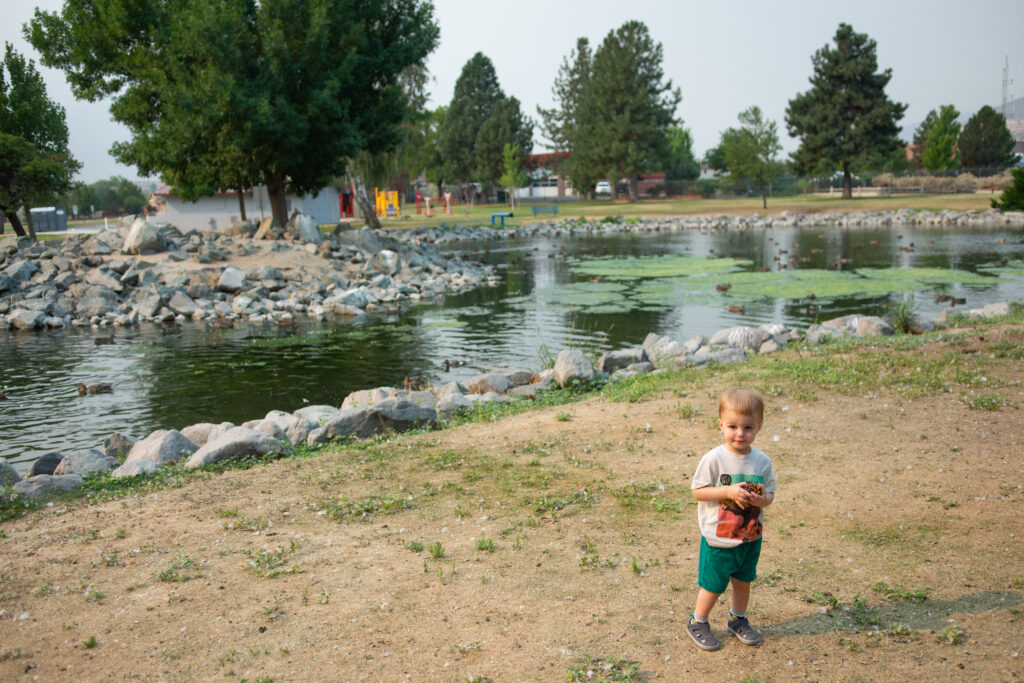
‘I have to move on’
Six months after testing positive for COVID-19, Katie Rankin is back to a semblance of normal life. She’s happy to be back at school, where she says she learns much better than she does online. She’s staying busy as a lifeguard and working on rebuilding her strength, with the hope of being able to return to swimming in the spring. She’s being intentional about trying to create community with those she works with.
But she also doesn’t know what normal looks like anymore. She says every year seems to bring with it the worst floods, the worst wildfires and, now, a pandemic.
“I had three-quarters of my freshman year and then we got shut down for ‘an extra long spring break,’ and now it is junior year and I’m looking at colleges,” Rankin said. “I honestly do not think that my high school experience, or even my college experience, will ever be normal. I keep telling my parents that this is the new normal.”
“They’re like, ‘No, this isn’t normal. This shouldn’t be normal,’” she added. “I’m like, ‘Well, it has to be, because I can’t deal with the mental capacity it takes to understand how horrible this is. I have to move on and live life as though it’s okay.’”
But it’s not easy. Swimming gave Katie an outlet to express her anxiety and emotions. Without that, and the friends she made on the team, she says it’s been harder for her to maintain good mental health. And, after being isolated during the worst of her illness in the spring, Katie said it’s overwhelming to be back in school with 3,500 students.
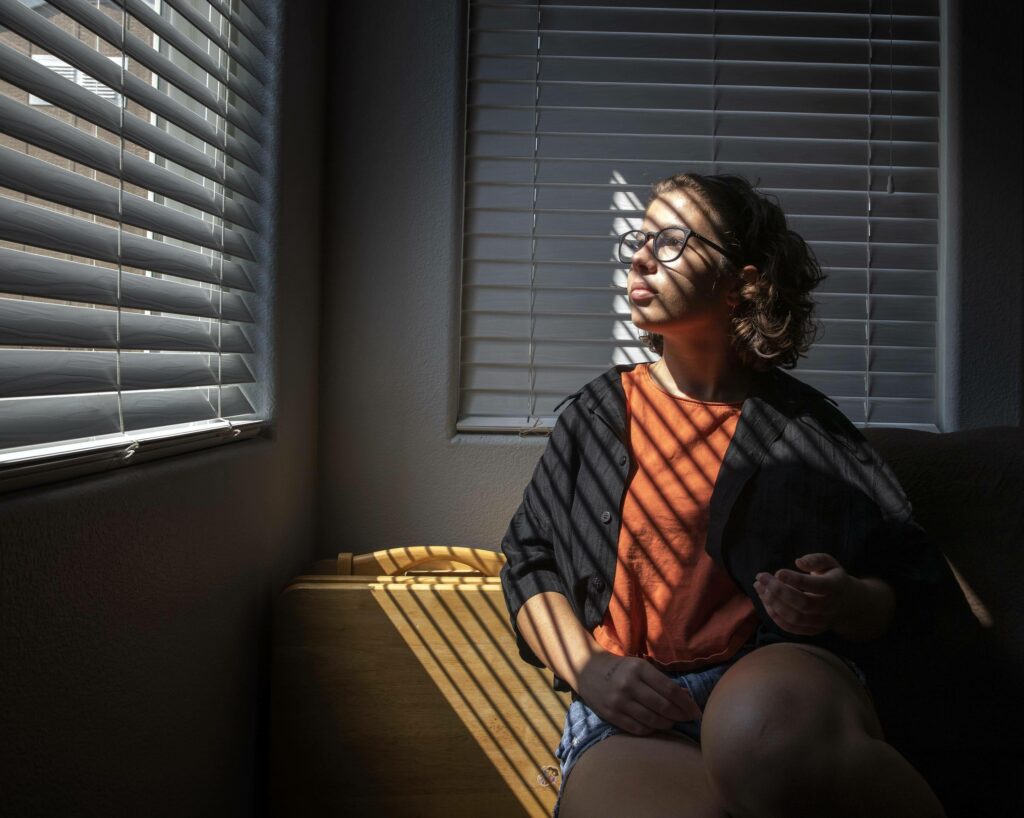
“I am really anxious being around that many people at once,” Katie said. “I’m really anxious being around that many people at once that are potentially not vaccinated and not wearing their masks all of the time they are at school.”
She says she wishes people knew that even if COVID isn’t a death sentence, it doesn’t mean their experience with the virus will be easy.
“In all likelihood, you probably aren’t going to die, but that doesn’t mean you aren’t going to struggle and that you aren’t going to have long-term issues and consequences from getting COVID. You might think, ‘Oh yes, I’m young. I’m fit. I’m in a good place.’ You might be. So was I,” she said. “With doing high school and friends and mental health, it takes a big toll on you. It’s a lot more than just, ‘Oh, I’m not going to die.’”
For Nate Young, life is starting to return to normal, too. He and his brother are back in school full time and active in sports.
But his mom, Nichole Young, can tell the last year has taken its toll on Nate. She says he’s always been a shy kid, but she feels like the last year and a half have caused him to withdraw even more. There were times when he was the only one on his soccer team wearing a neck gaiter during practice — just to make sure that he was staying safe — and she can tell that he’s become more standoffish playing soccer, where he was previously more aggressive.
Young is hopeful that getting vaccinated will finally give Nate the peace of mind to get back to a more normal life.
“It’ll be nice to see hopefully him come back out of his shell a little bit where he doesn’t feel so guarded all the time,” Young said.
Luckily, the shot is on the horizon. Nate’s 12th birthday is on Wednesday.
His mom wanted him to get the shot on his birthday, but Nate talked her into letting him get it three days later, so he doesn’t have to risk missing Thursday soccer practice and Saturday tryouts.
And as far as how Nate feels about getting the shot?
“Happy,” he says.
